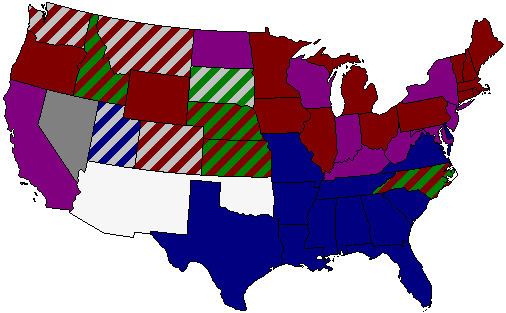Dates vary by state 1898 / 1899 → 15 7 2 7 Start date June 11, 1896 | 44 39 46 32 13 14 | |
 | ||
The United States Senate elections of 1896 and 1897 were elections in which the Democratic Party lost seven seats in the United States Senate, mostly to smaller third parties.
Contents
- Results summary
- Elections during the 54th Congress
- Elections leading to the 55th Congress
- Elections during the 55th Congress
- New York
- Pennsylvania
- South Carolina
- References
As these elections were prior to ratification of the seventeenth amendment, Senators were chosen by State legislatures.
Results summary
Senate Party Division, 55th Congress (1897–1899)
Elections during the 54th Congress
In these elections, the winners were seated during 1896 or in 1897 before March 4; ordered by election date.
Elections leading to the 55th Congress
In these general elections, the winners were elected for the term beginning March 4, 1897; ordered by state.
All of the elections involved the Class 3 seats.
Elections during the 55th Congress
In these elections, the winners were elected in 1897 after March 4; ordered by date.
New York
The election in New York was held on January 19, 1897 by the New York State Legislature. Democrat David B. Hill had been elected to this seat in 1891, and his term would expire on March 3, 1897. At the State election in November 1895, 36 Republicans and 14 Democrats were elected for a three-year term (1896-1898) in the State Senate. At the State election in November 1896, 114 Republicans and 36 Democrats were elected for the session of 1897 to the Assembly. The 120th New York State Legislature met from January 6 to April 24, 1897, at Albany, New York.
The Republican caucus met on January 14. 149 State legislators attended, and State Senator Cornelius R. Parsons (43rd D.), Ex-Mayor of Rochester, presided. The caucus nominated the Republican boss Thomas C. Platt, who had been briefly a U.S. Senator in 1881, on the first ballot.
The Democratic caucus met on January 18. 46 State legislators attended, but 5 walked out before the roll was called, after making speeches against Hill. The incumbent U.S. Senator David B. Hill was re-nominated.
Thomas C. Platt was the choice of both the Assembly and the State Senate, and was declared elected. Four anti-Hill Democrats voted for Labor leader Henry George who later the same year ran for Mayor of New York as a "Jefferson Democrat" but died a few days before the election.
Note: The votes were cast on January 19, but both Houses met in a joint session on January 20 to compare nominations, and declare the result.
Pennsylvania
The election in Pennsylvania was held January 19, 1897. Boies Penrose was elected by the Pennsylvania General Assembly. Incumbent Republican J. Donald Cameron, who was elected in an 1877 special election and subsequently re-elected in 1879, 1885, and 1891, was not a candidate for re-election. The Pennsylvania General Assembly, consisting of the House of Representatives and the Senate, convened on January 19, 1897, to elect a new Senator to fill the term beginning on March 4, 1897. The results of the vote of both houses combined are as follows:
South Carolina
The election in South Carolina was a unanimous election of the Democratic nominee on January 26, 1897. The Democratic primary election was held on August 26, 1896 and September 9. The Democratic Party of South Carolina organized primary elections for the U.S. Senate beginning in 1896 and the General Assembly would confirm the choice of the Democratic voters. Conservative Democratic Joseph H. Earle won the Democratic primary and was elected by the General Assembly for a six-year term.
In 1896, Governor of South Carolina John Gary Evans entered the first ever election in the state of South Carolina for the U.S. Senate. He had the backing of Senator Ben Tillman and much of the farming interests in the state. However, the farmers' movement had largely run its course and the Tillmanite reform movement had angered a considerable number of voters in the state. Conservative Joseph H. Earle and Newberry native John T. Duncan announced their candidacy's in opposition to Governor Evans. In the primary on August 26 Evans emerged as the frontrunner, but did not garner over 50% of the vote and was forced to face Earle in a runoff election. Those who had voted for Duncan threw their support to Earle and it provided him with the margin he needed for victory over Evans.
